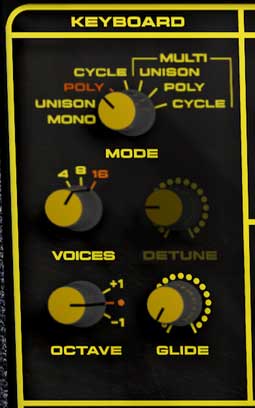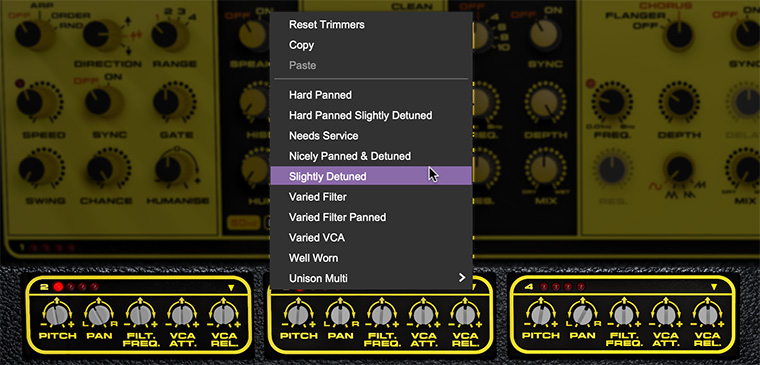
These controls set the number of simultaneously playable notes, as well as unison parameters, glide, octave transposition.
Mode- Determines the number of simultaneously playable notes. Yellowjacket features a super nifty and somewhat atypical "Multi" mode, so we strongly recommend reading this section.
Mono- One note sounds at a time with last-note priority mode, that is, the most recently played note always sounds. The Voices and Detune controls are dimmed and deactivated.
Unison- Unison stacks multiple voices monophonically according to the current Voices setting. The Detune knob spreads out the tuning of the oscillators for fat sounds. Note priority is always last-note, just like Mono mode.
Poly- Multiple keys can be played simultaneously with the maximum number of notes set by the Voices control. If the max number of voices is exceeded, the newest note gets stolen. When using the arpeggiator Poly mode, it will play the arp notes always from voice 1, which cuts off the release.
Cycle- Multiple keys can be played simultaneously with the maximum number of notes set by the Voices control. Yellowjacket sequentially plays through each voice as new notes are struck. If the max number of voices is exceeded, the newest note gets stolen. When using the arpeggiator Cycle mode, it steps through the voices, which allows the release to happen.
You can clearly visualize what's going on with poly voice assignment by setting Voices to 8 or16, and observing the voice LEDs as you play in Poly and Cycle modes.
Multi Voice Modes and the Multi Mode Voice Panels

The Multi voice modes let you add variation and color by altering parameters on a per-note basis. It may look a little scary initially, but we promise, it's super easy to use!
When a selection from the Multi keyboard mode is chosen, three Multi Mode Voice Panels are revealed, each containing "offset" trimmer controls that add or subtract from five key sound parameters: Pitch, Pan, Filter Frequency, VCA Envelope Attack, and VCA Envelope Release.
These Voice Panels emulate the ability of the original Wasp synthesizer to be chained through its proprietary LINK interface with additional Wasp synthesizers - each with their own slight variations - and controlled using EDP's Caterpillar polyphonic keyboard controller. With each note played, Yellowjacket cycles through: the first note played is uses the normal, unaltered synth parameters, the second note's parameters are offset by the trimmer settings in the #2 offset box, the third note by the settings in the #3 offset box, and so forth. Note that the LEDs next to the offset box # light to indicate which Multi voice is sounding.
An easy way to understand Multi mode functionality is to set Mode to Multi/Poly, and Voices to 4 (i.e. the maximum number of voices that can sound). In the #2 offset controls box on the bottom left, use the trimmer to set Pitch to something odd, like +9. Now slowly play and hold four consecutive notes. Hear how the pitch of the second note played is offset?
You may be wondering how the offset trimmer controls function when the Voices control is set to 8 or 16. In this case, the sequential nature of Multi mode repeats. If you look closely, you'll see that when Voices is set to 8, the main voice controls and each offset parameter box now have two voice active LEDs each. When voices is set to 16, each offset parameter box gets four voice active LEDs. If you're in Multi/Poly mode and a 5th note is played, the main voice sounds, when a 6th note is sounds, multi voice 2 sounds, and so on until a maximum of 16 voices is sounding (i.e. four LEDs for each multi voice), at which point the cycle starts over.
Let's go over how each Multi voice mode operates, then we'll detail the available offset parameters in the Voice Panels:
Mode- These are essentially the same as the "normal" keyboard modes, with the addition of Multi Mode Voice Panel parameter cycling.
Unison- Unison stacks multiple voices monophonically according to the current Voices setting. Since all voices play simultaneously in unison mode, they won't cycle through as with poly modes - they all play at once. The offset controls still work on individual voices, allowing super massive sounds. By retuning the Pitch trimmers of the synthesizer offsets to form triads, you can create one finger chords.
Note that the Detune knob still does its random-ish oscillator detuning thing on top of the offset box Pitch controls, so it's easy get out in the weeds tuning-wise.Poly- Multiple keys can be played simultaneously with the maximum number of notes set by the Voices control. The first available voice sounds - in other words, held notes will never get stolen. When playing one note at a time, the note will always sound from voice 1 of the primary synth. However, when playing multiple notes together, notes play sequentially and step to the next multi voice group.
Cycle- Multiple keys can be played simultaneously with the maximum number of notes set by the Voices control. In this mode, Yellowjacket will always sequentially play through each voice and offset synth as new notes are struck. If the max number of voices is exceeded, the newest note gets stolen.
Voices- Sets the maximum amount of voices that sound in poly modes. In unison modes, sets the number of simultaneously sounded voices when a single note is played. Also, the sweet 1980 album from Hall & Oates featuring the smash hit, "Kiss On My List."
Detune- Sets the amount of random oscillator detuning or "spread" when unison modes are used. Note that Detune is dimmed and deactivated in all other voice modes.
Octave- Transposes both oscillators up or down by one octave.
Glide-The Glide knob makes notes slide smoothly from one pitch to the next. Higher settings result in a slower change of pitch. Naturally, this works best in mono or unison modes, but if you're using glide in poly mode, the standard Poly mode is preferable to Cycle mode.
An interesting aspect of the original instrument is that its two oscillators glide at slightly different rates. We assume this was done for more musical effect, and we've made Yellowjacket work the same way. Glide will also slew/round off the Control Osc. waveforms as the original Wasp did.

Multi Mode Voice Panel Parameters
In Multi mode, three numbered Voice Panels are added to the interface, each representing an additional mono synth voice with an abstracted interface of five parameters. These settings have trimmers that can be adjusted to create an offset variation from Yellowjacket's primary synth. Each also includes quick access to a set of Voice Panel presets for all three panels. Adjustments made to these trimmers can be subtle to simulate the slight variations one might expect between multiple chained synthesizers or voice components. You can also apply extreme settings to produce single-fingered chords or patterns, stereo effects, and more.
Pitch- Fine tuning of the pitch, offset from the primary synthesizer settings, for the synth voice in a range from -12 to +12 semitones. By retuning the Pitch trimmers of the individual panels to form triads, you can create one-finger chords, or use in conjunction with the arpeggiator to create a transposable one-finger four-note step sequence.
Pan- Sets the % offset of output placement for the synth voice from left to right in the stereo image.
Filt. Freq.- Sets the % offset of the Filter Frequency for the synth voice, from -100% to +100%.
VCA Att.- Sets the % offset of the VCA Envelope Attack for the synth voice, from -100% to +100%.
VCA Rel.- Sets the % offset of the VCA Envelope Release for the synth voice, from -100% to +100%.
Presets- The downward-pointing arrow ▼ accesses a set of 10 primary panel configuration quick presets, such as Hard Panned, Slightly Detuned, Well Worn, and so on. Each preset applies pre-configured settings to all three voice panels at once to achieve the effect described.
Unison Multi is a collection of nine tuned panel sets primarily intended to be used when Keyboard mode is set to Multi / Unison mode, and includes individual tunings (Major, Minor, Major 7, etc.) and variations with hard panning. These are also useful for producing melodic sequences when used with the arpeggiator.
Also included are Reset Trimmers, Copy, and Paste. Unlike the presets detailed above, these commands are applied per single panel. For instance, selecting Reset Trimmers on synth panel 3 resets only that panel. Settings can also be copied from one panel and pasted to another without changing the third.